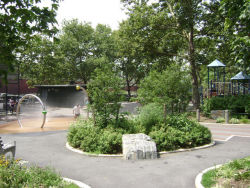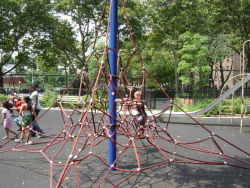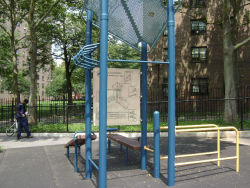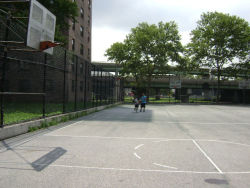Millbrook Playground
Mill Brook Playground - House Sparrows in New York City Parks
If you look around Mill Brook Playground, you will probably see house sparrows (Passer domesticus). This small, brown bird has a black bib (throat). Only 200 years ago, there were no house sparrows on the entire continent of North America. Today, it is estimated that there are over 150 million. The dramatic rise of the house sparrow in New York City and throughout North America can be attributed to 19th century industrialization and human manipulation of the environment.
There are conflicting rumors about why the sparrow was first brought to the United States. Some attribute its arrival to a group of well-read people who tried to introduce the birds mentioned in William Shakespeare’s plays into the United States. Others believe that a single man imported the sparrow from England because he wanted to be reminded of home. Most people, however, agree that the house sparrow was brought to the United States because it was an attractive bird that could also control the growing insect populations of the time.
To accommodate the burgeoning human population of the city during the first half of the 19th century, much of the natural landscape was cleared away to make room for new housing and commercial developments. This extensive industrialization drove out many of New York City’s native species, disturbing the natural balance of predator and prey. Insect infestations of trees and other plants became a major problem. Having heard that the house sparrows of European cities helped to control insect infestations, a group of New Yorkers imported eight pairs from England in 1850 and released them into the city. They survived for a time, but died before they were able to breed.
Soon afterward, Nicholas Pike, the director of the Brooklyn Institute, traveled to Liverpool, England to collect more sparrows. This time, 100 house sparrows were shipped back to the city. Half of them were released on arrival in 1851, while the other half were bred in Green-Wood Cemetery. These 50 birds were originally kept in the tower of the cemetery, but when they seemed unhappy, a leading citizen brought them to his house for the winter. The following year, these birds were released into the cemetery, where a man was employed just to take care of them.
This second wave succeeded where the first had failed. Due to the success of the introduction into Green-Wood Cemetery, several more shipments of sparrows arrived and were released in the cemetery and also Central Park, Union Square Park, and Madison Square Park. Other cities also imported sparrows from England or even from New York City, including Philadelphia, Salt Lake City, and San Francisco. While some considered the sparrows to be a loud nuisance, others were pleased that the birds were feeding on insects. In Boston, some citizens placed such a high value on their sparrows that a man was hired to shoot other birds that threatened them.
Mill Brook Playground is named for the stream that once flowed through the area from the North Bronx and emptied into the Bronx Kill. Also known as Saw Mill Creek, Mill Brook provided water that transported goods and powered many saw mills in the Bronx during the 18th and 19th century. The fruit orchards and dairy farms that used to be in this area were also ended by urban development. Human influence on the environment can also be seen in Mill Brook Playground in the form of house sparrows, which have flourished since their introduction to the city.
The house sparrow population grew so large because it was one of the first species to successfully populate urban areas. If there had been other dominant urban bird species, the house sparrow might not have survived. While the house sparrow population experienced a surge in one century, it has suffered a more recent decline due to the technological advances of the 20th century. As automobiles replaced horses for transportation and steel replaced wood for construction, the house sparrow could no longer nest in its usual areas and could not feed on oats scattered by horses. As the house sparrow population decreased, other species’ populations, such as the pigeon (Columbia livia), have grown. Despite declines in population, the house sparrow remains ubiquitous. Today, Parks discourages the feeding of birds or squirrels in playgrounds because the leftover food can attract rats.
Check out your park's Vital Signs
Clean & Safe
Green & Resilient
Empowered & Engaged Users
Share your feedback or learn more about how this park is part of a
Vital Park System








